CHCECE024: Developing Environments in Early Childhood Education
VerifiedAdded on 2023/01/13
|33
|7670
|98
Homework Assignment
AI Summary
This assignment addresses key aspects of early childhood education, focusing on developing appropriate settings and environments, and designing and implementing curriculum in consultation with others. The first part of the assignment involves analyzing an existing early childhood environment, identifying areas for improvement, and implementing modifications to enhance children's learning and engagement, specifically focusing on the creation of a collaborative learning experience related to respecting families and the community. The second part requires developing and implementing a curriculum, gathering parent feedback on the current curriculum, and identifying ways to improve it. The assignment emphasizes the importance of creating inclusive and stimulating environments, fostering children's appreciation of the natural world, and aligning educational practices with the Early Years Learning Framework (EYLF). The student provides detailed descriptions of environmental modifications, collaborative learning activities, and parent consultations, demonstrating an understanding of effective teaching strategies and child development principles.
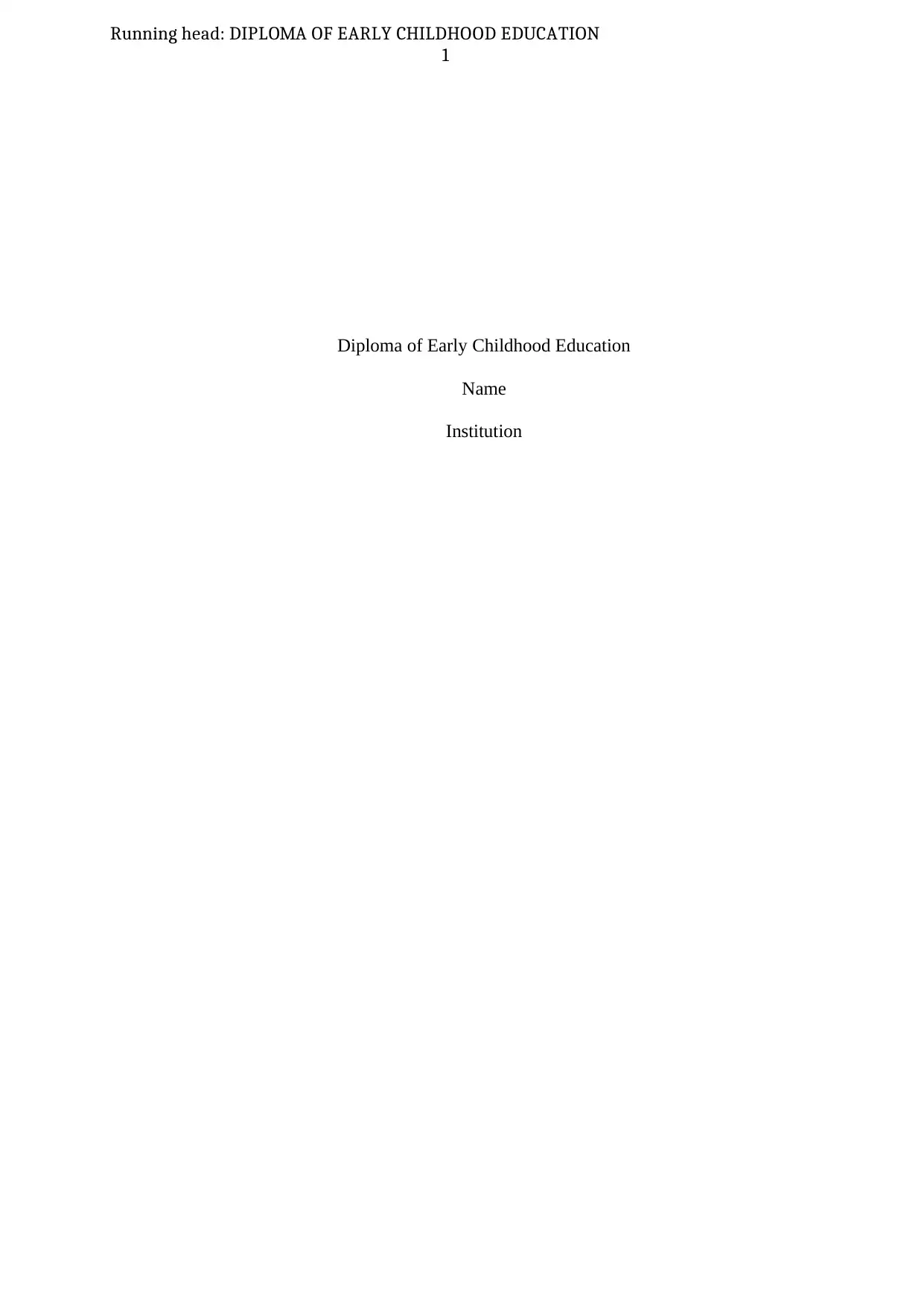
Running head: DIPLOMA OF EARLY CHILDHOOD EDUCATION
1
Diploma of Early Childhood Education
Name
Institution
1
Diploma of Early Childhood Education
Name
Institution
Paraphrase This Document
Need a fresh take? Get an instant paraphrase of this document with our AI Paraphraser
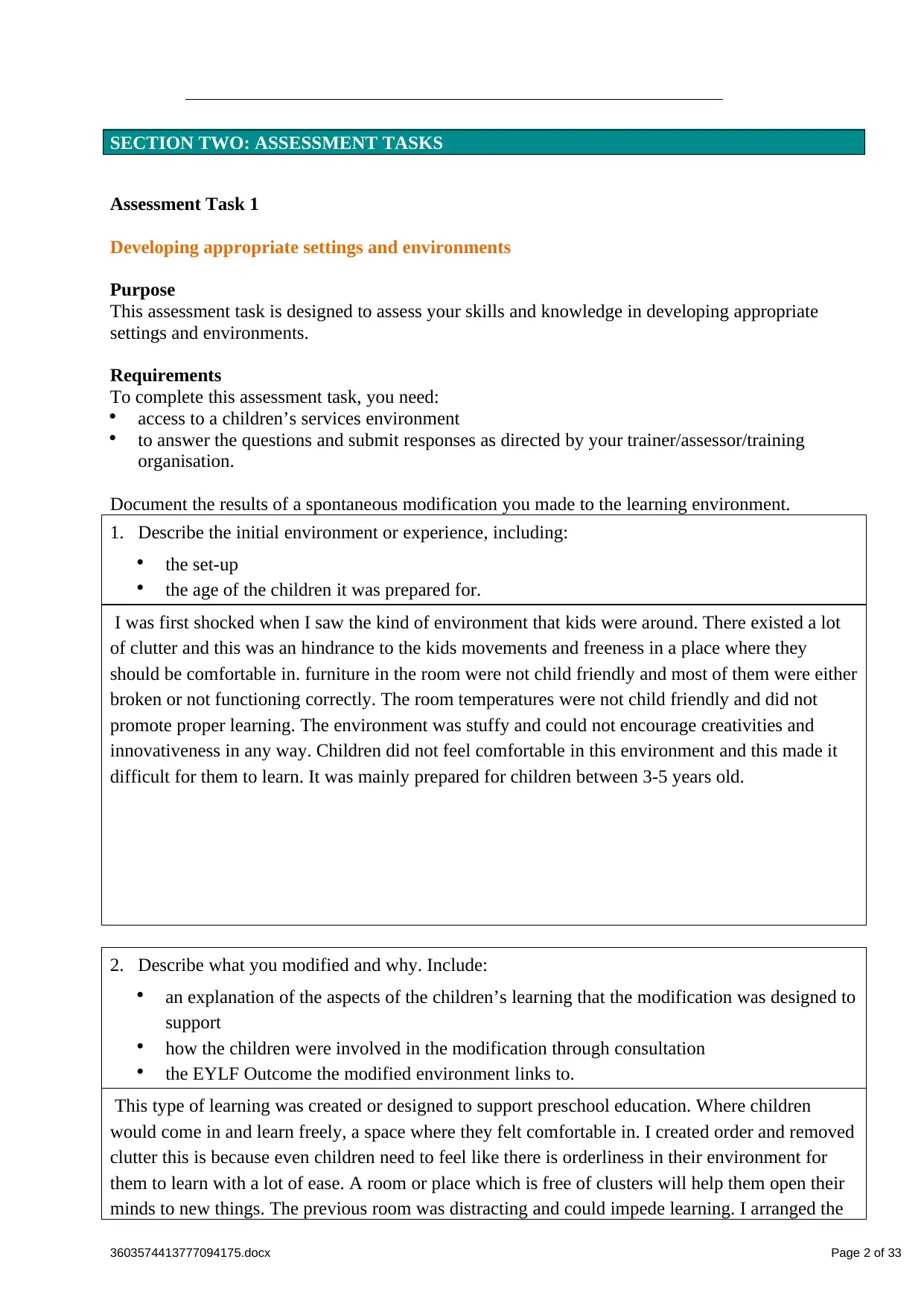
SECTION TWO: ASSESSMENT TASKS
Assessment Task 1
Developing appropriate settings and environments
Purpose
This assessment task is designed to assess your skills and knowledge in developing appropriate
settings and environments.
Requirements
To complete this assessment task, you need:
access to a children’s services environment
to answer the questions and submit responses as directed by your trainer/assessor/training
organisation.
Document the results of a spontaneous modification you made to the learning environment.
1. Describe the initial environment or experience, including:
the set-up
the age of the children it was prepared for.
I was first shocked when I saw the kind of environment that kids were around. There existed a lot
of clutter and this was an hindrance to the kids movements and freeness in a place where they
should be comfortable in. furniture in the room were not child friendly and most of them were either
broken or not functioning correctly. The room temperatures were not child friendly and did not
promote proper learning. The environment was stuffy and could not encourage creativities and
innovativeness in any way. Children did not feel comfortable in this environment and this made it
difficult for them to learn. It was mainly prepared for children between 3-5 years old.
2. Describe what you modified and why. Include:
an explanation of the aspects of the children’s learning that the modification was designed to
support
how the children were involved in the modification through consultation
the EYLF Outcome the modified environment links to.
This type of learning was created or designed to support preschool education. Where children
would come in and learn freely, a space where they felt comfortable in. I created order and removed
clutter this is because even children need to feel like there is orderliness in their environment for
them to learn with a lot of ease. A room or place which is free of clusters will help them open their
minds to new things. The previous room was distracting and could impede learning. I arranged the
3603574413777094175.docx Page 2 of 33
Assessment Task 1
Developing appropriate settings and environments
Purpose
This assessment task is designed to assess your skills and knowledge in developing appropriate
settings and environments.
Requirements
To complete this assessment task, you need:
access to a children’s services environment
to answer the questions and submit responses as directed by your trainer/assessor/training
organisation.
Document the results of a spontaneous modification you made to the learning environment.
1. Describe the initial environment or experience, including:
the set-up
the age of the children it was prepared for.
I was first shocked when I saw the kind of environment that kids were around. There existed a lot
of clutter and this was an hindrance to the kids movements and freeness in a place where they
should be comfortable in. furniture in the room were not child friendly and most of them were either
broken or not functioning correctly. The room temperatures were not child friendly and did not
promote proper learning. The environment was stuffy and could not encourage creativities and
innovativeness in any way. Children did not feel comfortable in this environment and this made it
difficult for them to learn. It was mainly prepared for children between 3-5 years old.
2. Describe what you modified and why. Include:
an explanation of the aspects of the children’s learning that the modification was designed to
support
how the children were involved in the modification through consultation
the EYLF Outcome the modified environment links to.
This type of learning was created or designed to support preschool education. Where children
would come in and learn freely, a space where they felt comfortable in. I created order and removed
clutter this is because even children need to feel like there is orderliness in their environment for
them to learn with a lot of ease. A room or place which is free of clusters will help them open their
minds to new things. The previous room was distracting and could impede learning. I arranged the
3603574413777094175.docx Page 2 of 33
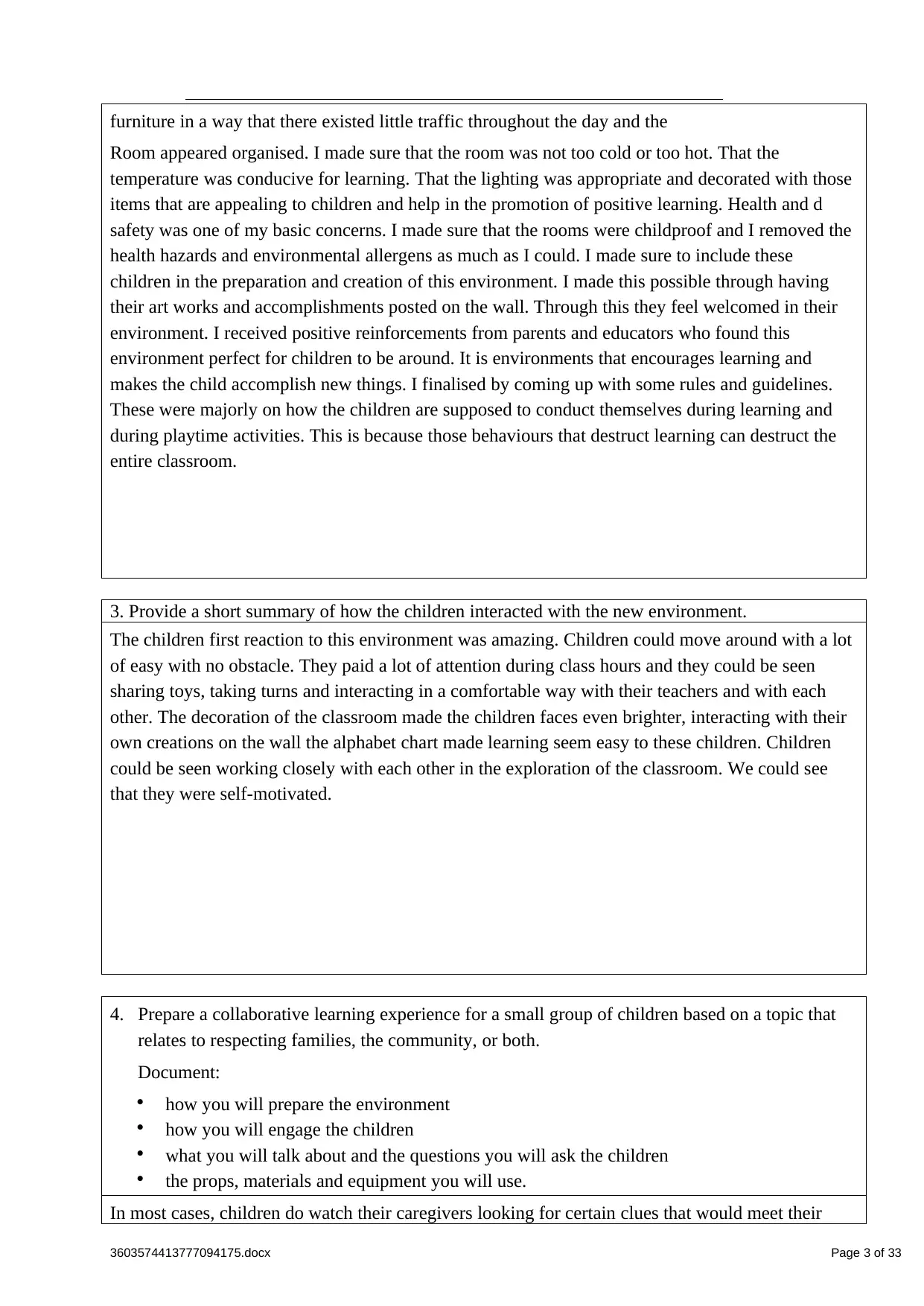
furniture in a way that there existed little traffic throughout the day and the
Room appeared organised. I made sure that the room was not too cold or too hot. That the
temperature was conducive for learning. That the lighting was appropriate and decorated with those
items that are appealing to children and help in the promotion of positive learning. Health and d
safety was one of my basic concerns. I made sure that the rooms were childproof and I removed the
health hazards and environmental allergens as much as I could. I made sure to include these
children in the preparation and creation of this environment. I made this possible through having
their art works and accomplishments posted on the wall. Through this they feel welcomed in their
environment. I received positive reinforcements from parents and educators who found this
environment perfect for children to be around. It is environments that encourages learning and
makes the child accomplish new things. I finalised by coming up with some rules and guidelines.
These were majorly on how the children are supposed to conduct themselves during learning and
during playtime activities. This is because those behaviours that destruct learning can destruct the
entire classroom.
3. Provide a short summary of how the children interacted with the new environment.
The children first reaction to this environment was amazing. Children could move around with a lot
of easy with no obstacle. They paid a lot of attention during class hours and they could be seen
sharing toys, taking turns and interacting in a comfortable way with their teachers and with each
other. The decoration of the classroom made the children faces even brighter, interacting with their
own creations on the wall the alphabet chart made learning seem easy to these children. Children
could be seen working closely with each other in the exploration of the classroom. We could see
that they were self-motivated.
4. Prepare a collaborative learning experience for a small group of children based on a topic that
relates to respecting families, the community, or both.
Document:
how you will prepare the environment
how you will engage the children
what you will talk about and the questions you will ask the children
the props, materials and equipment you will use.
In most cases, children do watch their caregivers looking for certain clues that would meet their
3603574413777094175.docx Page 3 of 33
Room appeared organised. I made sure that the room was not too cold or too hot. That the
temperature was conducive for learning. That the lighting was appropriate and decorated with those
items that are appealing to children and help in the promotion of positive learning. Health and d
safety was one of my basic concerns. I made sure that the rooms were childproof and I removed the
health hazards and environmental allergens as much as I could. I made sure to include these
children in the preparation and creation of this environment. I made this possible through having
their art works and accomplishments posted on the wall. Through this they feel welcomed in their
environment. I received positive reinforcements from parents and educators who found this
environment perfect for children to be around. It is environments that encourages learning and
makes the child accomplish new things. I finalised by coming up with some rules and guidelines.
These were majorly on how the children are supposed to conduct themselves during learning and
during playtime activities. This is because those behaviours that destruct learning can destruct the
entire classroom.
3. Provide a short summary of how the children interacted with the new environment.
The children first reaction to this environment was amazing. Children could move around with a lot
of easy with no obstacle. They paid a lot of attention during class hours and they could be seen
sharing toys, taking turns and interacting in a comfortable way with their teachers and with each
other. The decoration of the classroom made the children faces even brighter, interacting with their
own creations on the wall the alphabet chart made learning seem easy to these children. Children
could be seen working closely with each other in the exploration of the classroom. We could see
that they were self-motivated.
4. Prepare a collaborative learning experience for a small group of children based on a topic that
relates to respecting families, the community, or both.
Document:
how you will prepare the environment
how you will engage the children
what you will talk about and the questions you will ask the children
the props, materials and equipment you will use.
In most cases, children do watch their caregivers looking for certain clues that would meet their
3603574413777094175.docx Page 3 of 33
⊘ This is a preview!⊘
Do you want full access?
Subscribe today to unlock all pages.

Trusted by 1+ million students worldwide
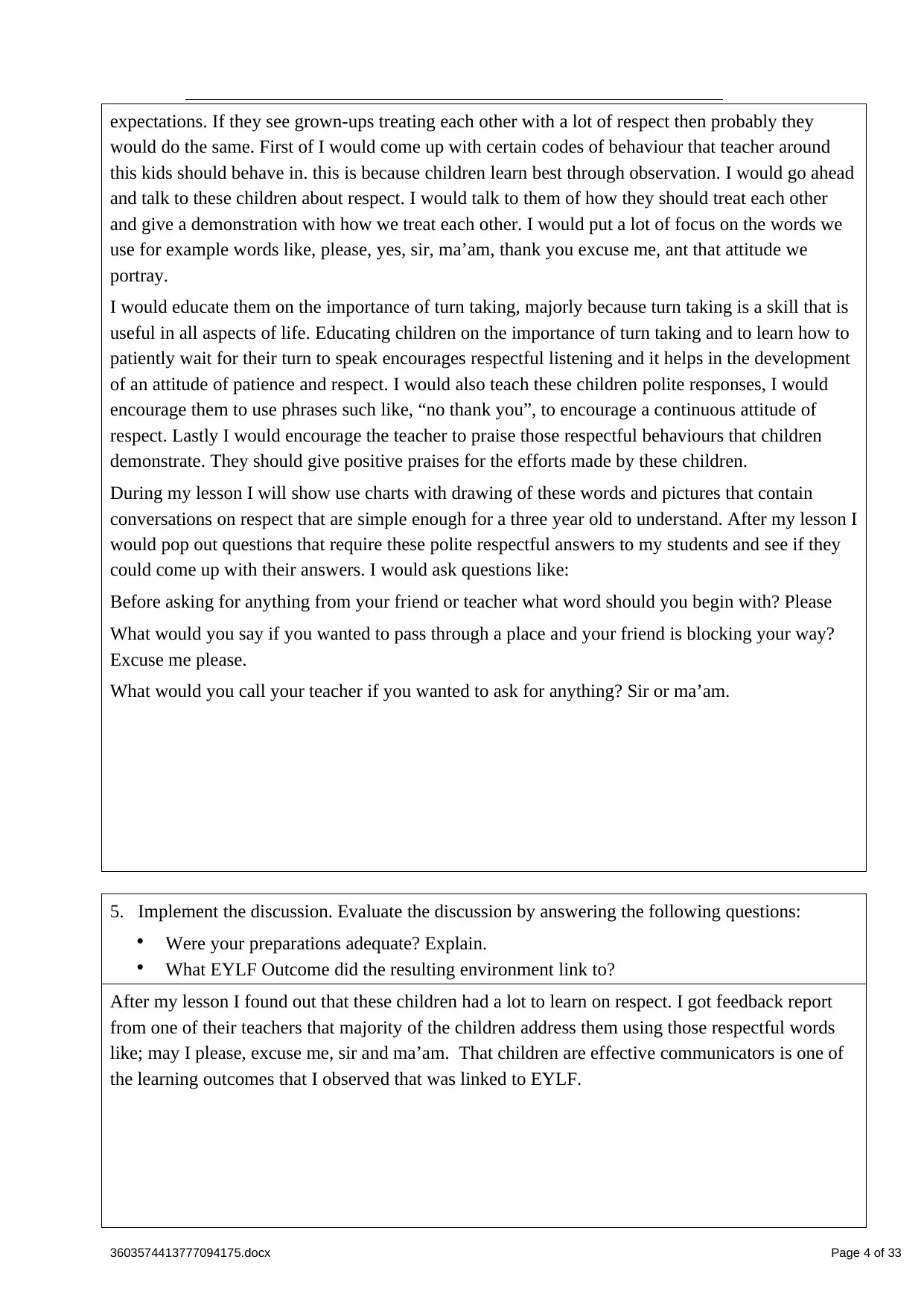
expectations. If they see grown-ups treating each other with a lot of respect then probably they
would do the same. First of I would come up with certain codes of behaviour that teacher around
this kids should behave in. this is because children learn best through observation. I would go ahead
and talk to these children about respect. I would talk to them of how they should treat each other
and give a demonstration with how we treat each other. I would put a lot of focus on the words we
use for example words like, please, yes, sir, ma’am, thank you excuse me, ant that attitude we
portray.
I would educate them on the importance of turn taking, majorly because turn taking is a skill that is
useful in all aspects of life. Educating children on the importance of turn taking and to learn how to
patiently wait for their turn to speak encourages respectful listening and it helps in the development
of an attitude of patience and respect. I would also teach these children polite responses, I would
encourage them to use phrases such like, “no thank you”, to encourage a continuous attitude of
respect. Lastly I would encourage the teacher to praise those respectful behaviours that children
demonstrate. They should give positive praises for the efforts made by these children.
During my lesson I will show use charts with drawing of these words and pictures that contain
conversations on respect that are simple enough for a three year old to understand. After my lesson I
would pop out questions that require these polite respectful answers to my students and see if they
could come up with their answers. I would ask questions like:
Before asking for anything from your friend or teacher what word should you begin with? Please
What would you say if you wanted to pass through a place and your friend is blocking your way?
Excuse me please.
What would you call your teacher if you wanted to ask for anything? Sir or ma’am.
5. Implement the discussion. Evaluate the discussion by answering the following questions:
Were your preparations adequate? Explain.
What EYLF Outcome did the resulting environment link to?
After my lesson I found out that these children had a lot to learn on respect. I got feedback report
from one of their teachers that majority of the children address them using those respectful words
like; may I please, excuse me, sir and ma’am. That children are effective communicators is one of
the learning outcomes that I observed that was linked to EYLF.
3603574413777094175.docx Page 4 of 33
would do the same. First of I would come up with certain codes of behaviour that teacher around
this kids should behave in. this is because children learn best through observation. I would go ahead
and talk to these children about respect. I would talk to them of how they should treat each other
and give a demonstration with how we treat each other. I would put a lot of focus on the words we
use for example words like, please, yes, sir, ma’am, thank you excuse me, ant that attitude we
portray.
I would educate them on the importance of turn taking, majorly because turn taking is a skill that is
useful in all aspects of life. Educating children on the importance of turn taking and to learn how to
patiently wait for their turn to speak encourages respectful listening and it helps in the development
of an attitude of patience and respect. I would also teach these children polite responses, I would
encourage them to use phrases such like, “no thank you”, to encourage a continuous attitude of
respect. Lastly I would encourage the teacher to praise those respectful behaviours that children
demonstrate. They should give positive praises for the efforts made by these children.
During my lesson I will show use charts with drawing of these words and pictures that contain
conversations on respect that are simple enough for a three year old to understand. After my lesson I
would pop out questions that require these polite respectful answers to my students and see if they
could come up with their answers. I would ask questions like:
Before asking for anything from your friend or teacher what word should you begin with? Please
What would you say if you wanted to pass through a place and your friend is blocking your way?
Excuse me please.
What would you call your teacher if you wanted to ask for anything? Sir or ma’am.
5. Implement the discussion. Evaluate the discussion by answering the following questions:
Were your preparations adequate? Explain.
What EYLF Outcome did the resulting environment link to?
After my lesson I found out that these children had a lot to learn on respect. I got feedback report
from one of their teachers that majority of the children address them using those respectful words
like; may I please, excuse me, sir and ma’am. That children are effective communicators is one of
the learning outcomes that I observed that was linked to EYLF.
3603574413777094175.docx Page 4 of 33
Paraphrase This Document
Need a fresh take? Get an instant paraphrase of this document with our AI Paraphraser
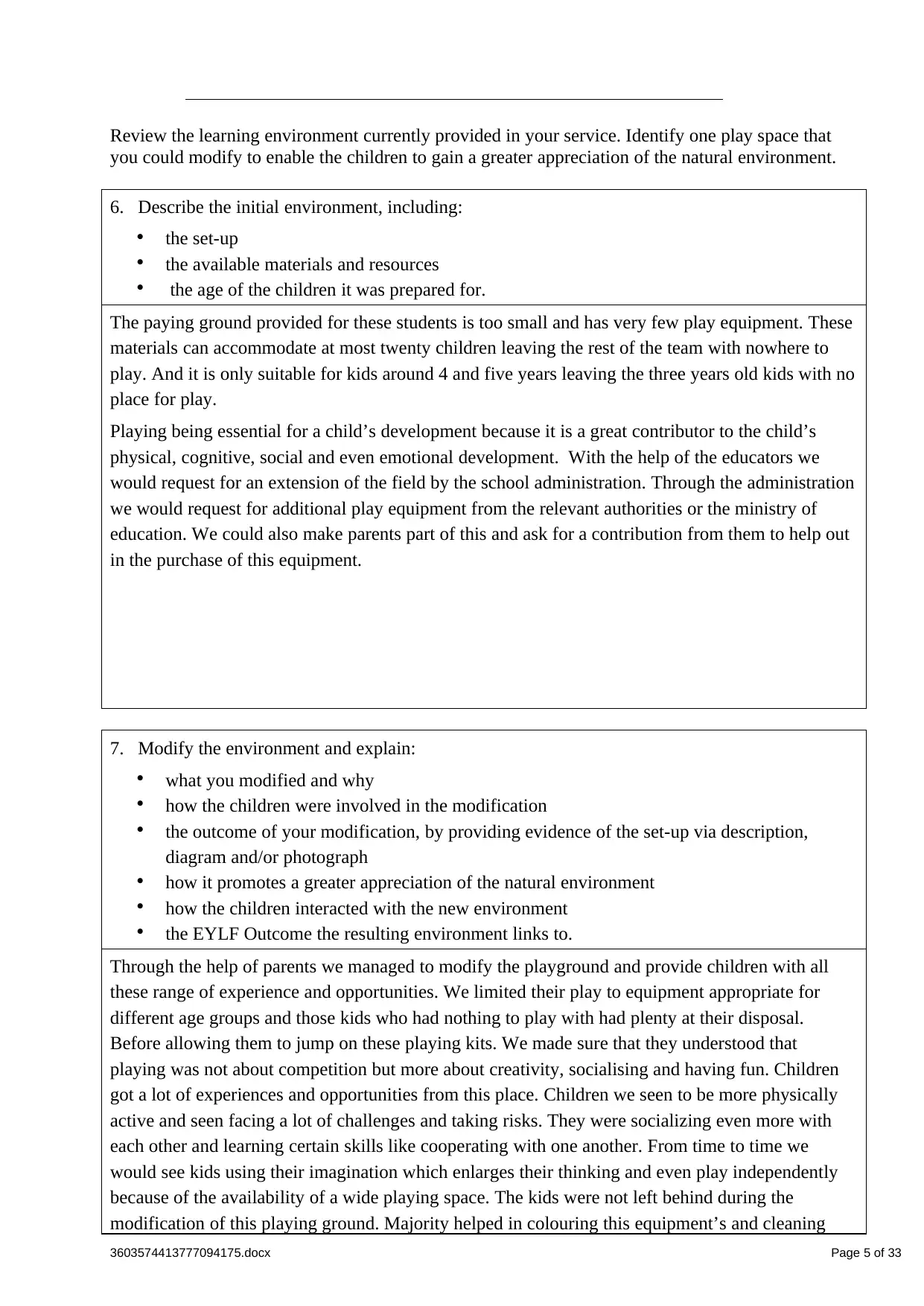
Review the learning environment currently provided in your service. Identify one play space that
you could modify to enable the children to gain a greater appreciation of the natural environment.
6. Describe the initial environment, including:
the set-up
the available materials and resources
the age of the children it was prepared for.
The paying ground provided for these students is too small and has very few play equipment. These
materials can accommodate at most twenty children leaving the rest of the team with nowhere to
play. And it is only suitable for kids around 4 and five years leaving the three years old kids with no
place for play.
Playing being essential for a child’s development because it is a great contributor to the child’s
physical, cognitive, social and even emotional development. With the help of the educators we
would request for an extension of the field by the school administration. Through the administration
we would request for additional play equipment from the relevant authorities or the ministry of
education. We could also make parents part of this and ask for a contribution from them to help out
in the purchase of this equipment.
7. Modify the environment and explain:
what you modified and why
how the children were involved in the modification
the outcome of your modification, by providing evidence of the set-up via description,
diagram and/or photograph
how it promotes a greater appreciation of the natural environment
how the children interacted with the new environment
the EYLF Outcome the resulting environment links to.
Through the help of parents we managed to modify the playground and provide children with all
these range of experience and opportunities. We limited their play to equipment appropriate for
different age groups and those kids who had nothing to play with had plenty at their disposal.
Before allowing them to jump on these playing kits. We made sure that they understood that
playing was not about competition but more about creativity, socialising and having fun. Children
got a lot of experiences and opportunities from this place. Children we seen to be more physically
active and seen facing a lot of challenges and taking risks. They were socializing even more with
each other and learning certain skills like cooperating with one another. From time to time we
would see kids using their imagination which enlarges their thinking and even play independently
because of the availability of a wide playing space. The kids were not left behind during the
modification of this playing ground. Majority helped in colouring this equipment’s and cleaning
3603574413777094175.docx Page 5 of 33
you could modify to enable the children to gain a greater appreciation of the natural environment.
6. Describe the initial environment, including:
the set-up
the available materials and resources
the age of the children it was prepared for.
The paying ground provided for these students is too small and has very few play equipment. These
materials can accommodate at most twenty children leaving the rest of the team with nowhere to
play. And it is only suitable for kids around 4 and five years leaving the three years old kids with no
place for play.
Playing being essential for a child’s development because it is a great contributor to the child’s
physical, cognitive, social and even emotional development. With the help of the educators we
would request for an extension of the field by the school administration. Through the administration
we would request for additional play equipment from the relevant authorities or the ministry of
education. We could also make parents part of this and ask for a contribution from them to help out
in the purchase of this equipment.
7. Modify the environment and explain:
what you modified and why
how the children were involved in the modification
the outcome of your modification, by providing evidence of the set-up via description,
diagram and/or photograph
how it promotes a greater appreciation of the natural environment
how the children interacted with the new environment
the EYLF Outcome the resulting environment links to.
Through the help of parents we managed to modify the playground and provide children with all
these range of experience and opportunities. We limited their play to equipment appropriate for
different age groups and those kids who had nothing to play with had plenty at their disposal.
Before allowing them to jump on these playing kits. We made sure that they understood that
playing was not about competition but more about creativity, socialising and having fun. Children
got a lot of experiences and opportunities from this place. Children we seen to be more physically
active and seen facing a lot of challenges and taking risks. They were socializing even more with
each other and learning certain skills like cooperating with one another. From time to time we
would see kids using their imagination which enlarges their thinking and even play independently
because of the availability of a wide playing space. The kids were not left behind during the
modification of this playing ground. Majority helped in colouring this equipment’s and cleaning
3603574413777094175.docx Page 5 of 33
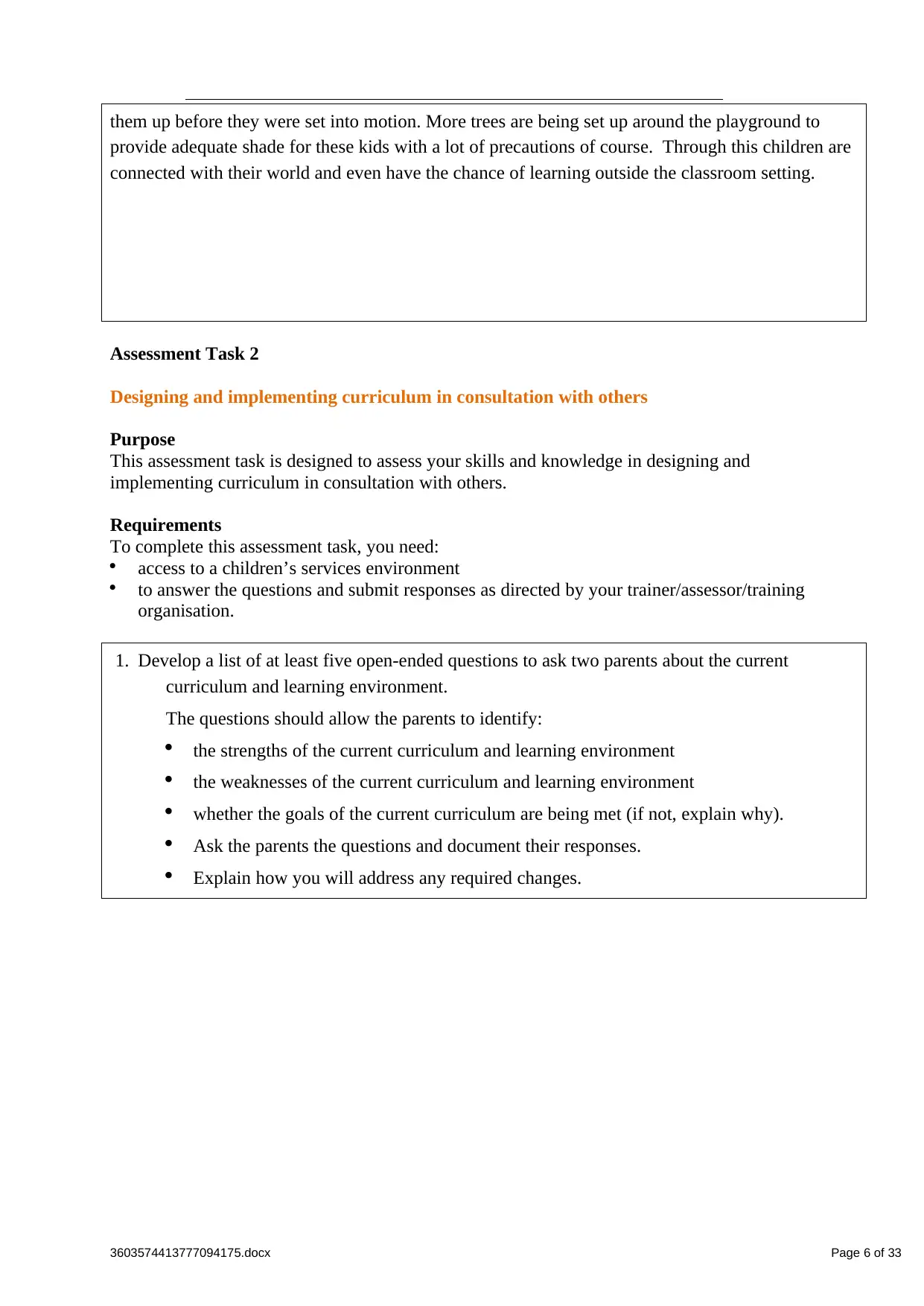
them up before they were set into motion. More trees are being set up around the playground to
provide adequate shade for these kids with a lot of precautions of course. Through this children are
connected with their world and even have the chance of learning outside the classroom setting.
Assessment Task 2
Designing and implementing curriculum in consultation with others
Purpose
This assessment task is designed to assess your skills and knowledge in designing and
implementing curriculum in consultation with others.
Requirements
To complete this assessment task, you need:
access to a children’s services environment
to answer the questions and submit responses as directed by your trainer/assessor/training
organisation.
1. Develop a list of at least five open-ended questions to ask two parents about the current
curriculum and learning environment.
The questions should allow the parents to identify:
the strengths of the current curriculum and learning environment
the weaknesses of the current curriculum and learning environment
whether the goals of the current curriculum are being met (if not, explain why).
Ask the parents the questions and document their responses.
Explain how you will address any required changes.
3603574413777094175.docx Page 6 of 33
provide adequate shade for these kids with a lot of precautions of course. Through this children are
connected with their world and even have the chance of learning outside the classroom setting.
Assessment Task 2
Designing and implementing curriculum in consultation with others
Purpose
This assessment task is designed to assess your skills and knowledge in designing and
implementing curriculum in consultation with others.
Requirements
To complete this assessment task, you need:
access to a children’s services environment
to answer the questions and submit responses as directed by your trainer/assessor/training
organisation.
1. Develop a list of at least five open-ended questions to ask two parents about the current
curriculum and learning environment.
The questions should allow the parents to identify:
the strengths of the current curriculum and learning environment
the weaknesses of the current curriculum and learning environment
whether the goals of the current curriculum are being met (if not, explain why).
Ask the parents the questions and document their responses.
Explain how you will address any required changes.
3603574413777094175.docx Page 6 of 33
⊘ This is a preview!⊘
Do you want full access?
Subscribe today to unlock all pages.

Trusted by 1+ million students worldwide
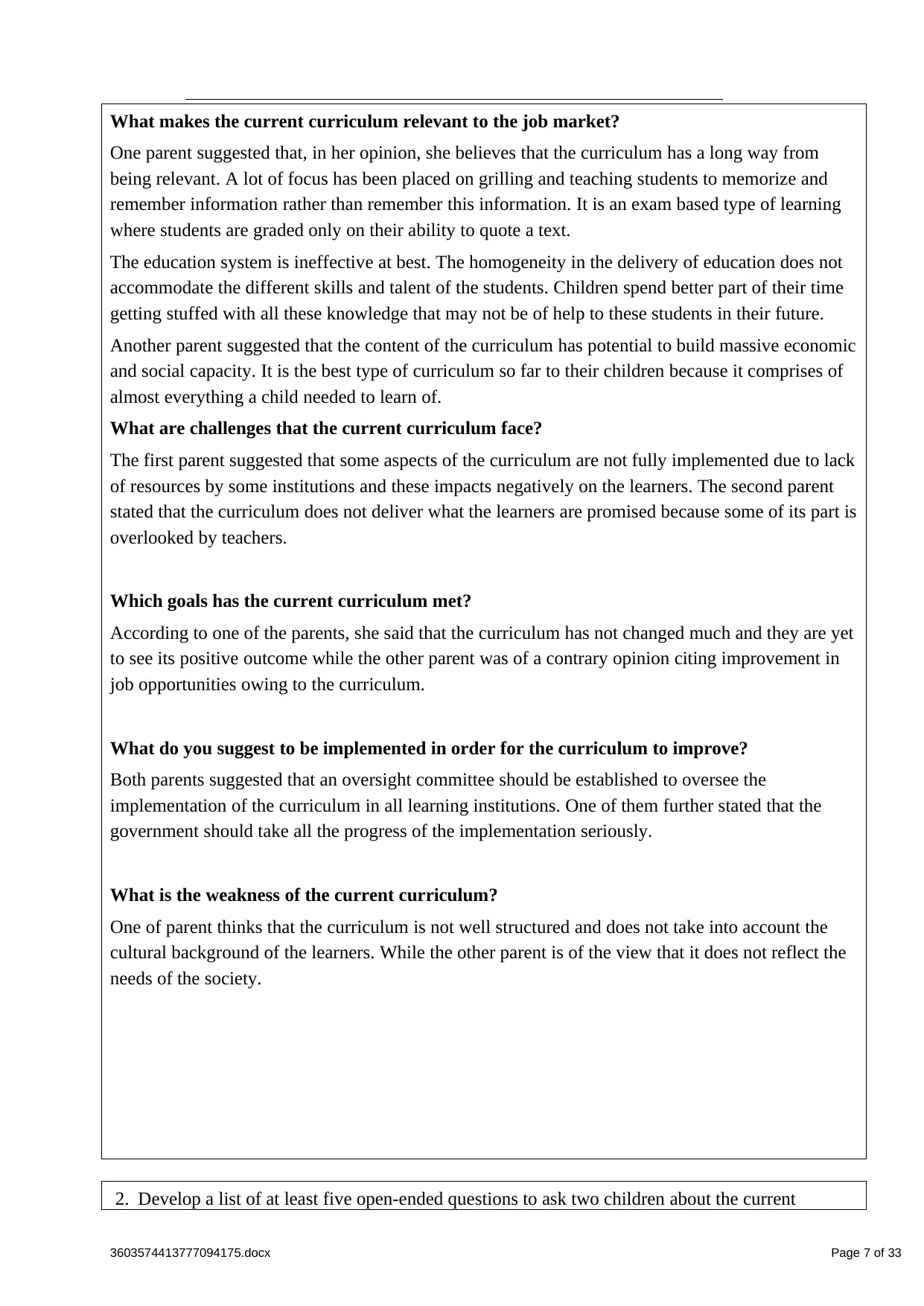
What makes the current curriculum relevant to the job market?
One parent suggested that, in her opinion, she believes that the curriculum has a long way from
being relevant. A lot of focus has been placed on grilling and teaching students to memorize and
remember information rather than remember this information. It is an exam based type of learning
where students are graded only on their ability to quote a text.
The education system is ineffective at best. The homogeneity in the delivery of education does not
accommodate the different skills and talent of the students. Children spend better part of their time
getting stuffed with all these knowledge that may not be of help to these students in their future.
Another parent suggested that the content of the curriculum has potential to build massive economic
and social capacity. It is the best type of curriculum so far to their children because it comprises of
almost everything a child needed to learn of.
What are challenges that the current curriculum face?
The first parent suggested that some aspects of the curriculum are not fully implemented due to lack
of resources by some institutions and these impacts negatively on the learners. The second parent
stated that the curriculum does not deliver what the learners are promised because some of its part is
overlooked by teachers.
Which goals has the current curriculum met?
According to one of the parents, she said that the curriculum has not changed much and they are yet
to see its positive outcome while the other parent was of a contrary opinion citing improvement in
job opportunities owing to the curriculum.
What do you suggest to be implemented in order for the curriculum to improve?
Both parents suggested that an oversight committee should be established to oversee the
implementation of the curriculum in all learning institutions. One of them further stated that the
government should take all the progress of the implementation seriously.
What is the weakness of the current curriculum?
One of parent thinks that the curriculum is not well structured and does not take into account the
cultural background of the learners. While the other parent is of the view that it does not reflect the
needs of the society.
2. Develop a list of at least five open-ended questions to ask two children about the current
3603574413777094175.docx Page 7 of 33
One parent suggested that, in her opinion, she believes that the curriculum has a long way from
being relevant. A lot of focus has been placed on grilling and teaching students to memorize and
remember information rather than remember this information. It is an exam based type of learning
where students are graded only on their ability to quote a text.
The education system is ineffective at best. The homogeneity in the delivery of education does not
accommodate the different skills and talent of the students. Children spend better part of their time
getting stuffed with all these knowledge that may not be of help to these students in their future.
Another parent suggested that the content of the curriculum has potential to build massive economic
and social capacity. It is the best type of curriculum so far to their children because it comprises of
almost everything a child needed to learn of.
What are challenges that the current curriculum face?
The first parent suggested that some aspects of the curriculum are not fully implemented due to lack
of resources by some institutions and these impacts negatively on the learners. The second parent
stated that the curriculum does not deliver what the learners are promised because some of its part is
overlooked by teachers.
Which goals has the current curriculum met?
According to one of the parents, she said that the curriculum has not changed much and they are yet
to see its positive outcome while the other parent was of a contrary opinion citing improvement in
job opportunities owing to the curriculum.
What do you suggest to be implemented in order for the curriculum to improve?
Both parents suggested that an oversight committee should be established to oversee the
implementation of the curriculum in all learning institutions. One of them further stated that the
government should take all the progress of the implementation seriously.
What is the weakness of the current curriculum?
One of parent thinks that the curriculum is not well structured and does not take into account the
cultural background of the learners. While the other parent is of the view that it does not reflect the
needs of the society.
2. Develop a list of at least five open-ended questions to ask two children about the current
3603574413777094175.docx Page 7 of 33
Paraphrase This Document
Need a fresh take? Get an instant paraphrase of this document with our AI Paraphraser
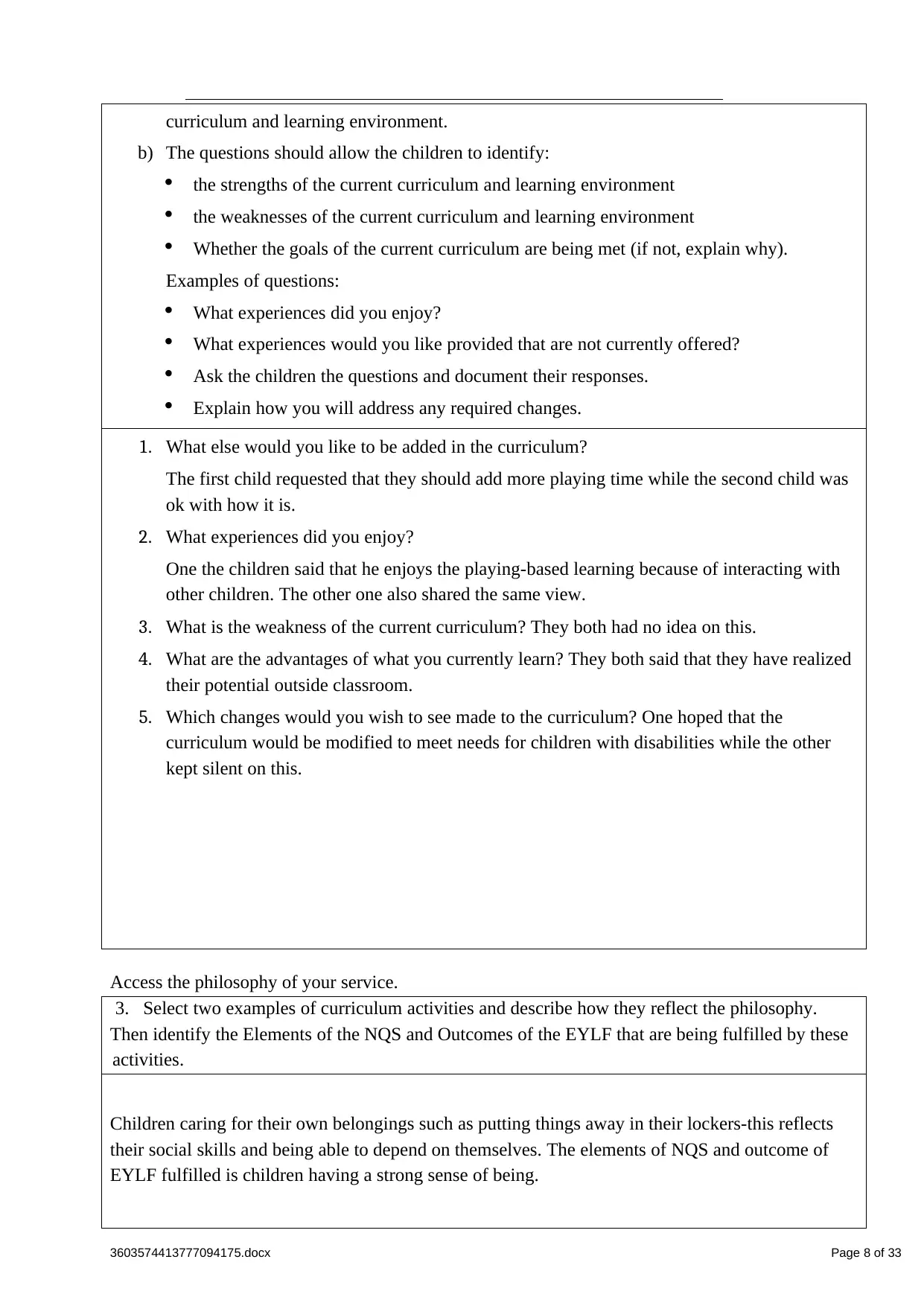
curriculum and learning environment.
b) The questions should allow the children to identify:
the strengths of the current curriculum and learning environment
the weaknesses of the current curriculum and learning environment
Whether the goals of the current curriculum are being met (if not, explain why).
Examples of questions:
What experiences did you enjoy?
What experiences would you like provided that are not currently offered?
Ask the children the questions and document their responses.
Explain how you will address any required changes.
1. What else would you like to be added in the curriculum?
The first child requested that they should add more playing time while the second child was
ok with how it is.
2. What experiences did you enjoy?
One the children said that he enjoys the playing-based learning because of interacting with
other children. The other one also shared the same view.
3. What is the weakness of the current curriculum? They both had no idea on this.
4. What are the advantages of what you currently learn? They both said that they have realized
their potential outside classroom.
5. Which changes would you wish to see made to the curriculum? One hoped that the
curriculum would be modified to meet needs for children with disabilities while the other
kept silent on this.
Access the philosophy of your service.
3. Select two examples of curriculum activities and describe how they reflect the philosophy.
Then identify the Elements of the NQS and Outcomes of the EYLF that are being fulfilled by these
activities.
Children caring for their own belongings such as putting things away in their lockers-this reflects
their social skills and being able to depend on themselves. The elements of NQS and outcome of
EYLF fulfilled is children having a strong sense of being.
3603574413777094175.docx Page 8 of 33
b) The questions should allow the children to identify:
the strengths of the current curriculum and learning environment
the weaknesses of the current curriculum and learning environment
Whether the goals of the current curriculum are being met (if not, explain why).
Examples of questions:
What experiences did you enjoy?
What experiences would you like provided that are not currently offered?
Ask the children the questions and document their responses.
Explain how you will address any required changes.
1. What else would you like to be added in the curriculum?
The first child requested that they should add more playing time while the second child was
ok with how it is.
2. What experiences did you enjoy?
One the children said that he enjoys the playing-based learning because of interacting with
other children. The other one also shared the same view.
3. What is the weakness of the current curriculum? They both had no idea on this.
4. What are the advantages of what you currently learn? They both said that they have realized
their potential outside classroom.
5. Which changes would you wish to see made to the curriculum? One hoped that the
curriculum would be modified to meet needs for children with disabilities while the other
kept silent on this.
Access the philosophy of your service.
3. Select two examples of curriculum activities and describe how they reflect the philosophy.
Then identify the Elements of the NQS and Outcomes of the EYLF that are being fulfilled by these
activities.
Children caring for their own belongings such as putting things away in their lockers-this reflects
their social skills and being able to depend on themselves. The elements of NQS and outcome of
EYLF fulfilled is children having a strong sense of being.
3603574413777094175.docx Page 8 of 33
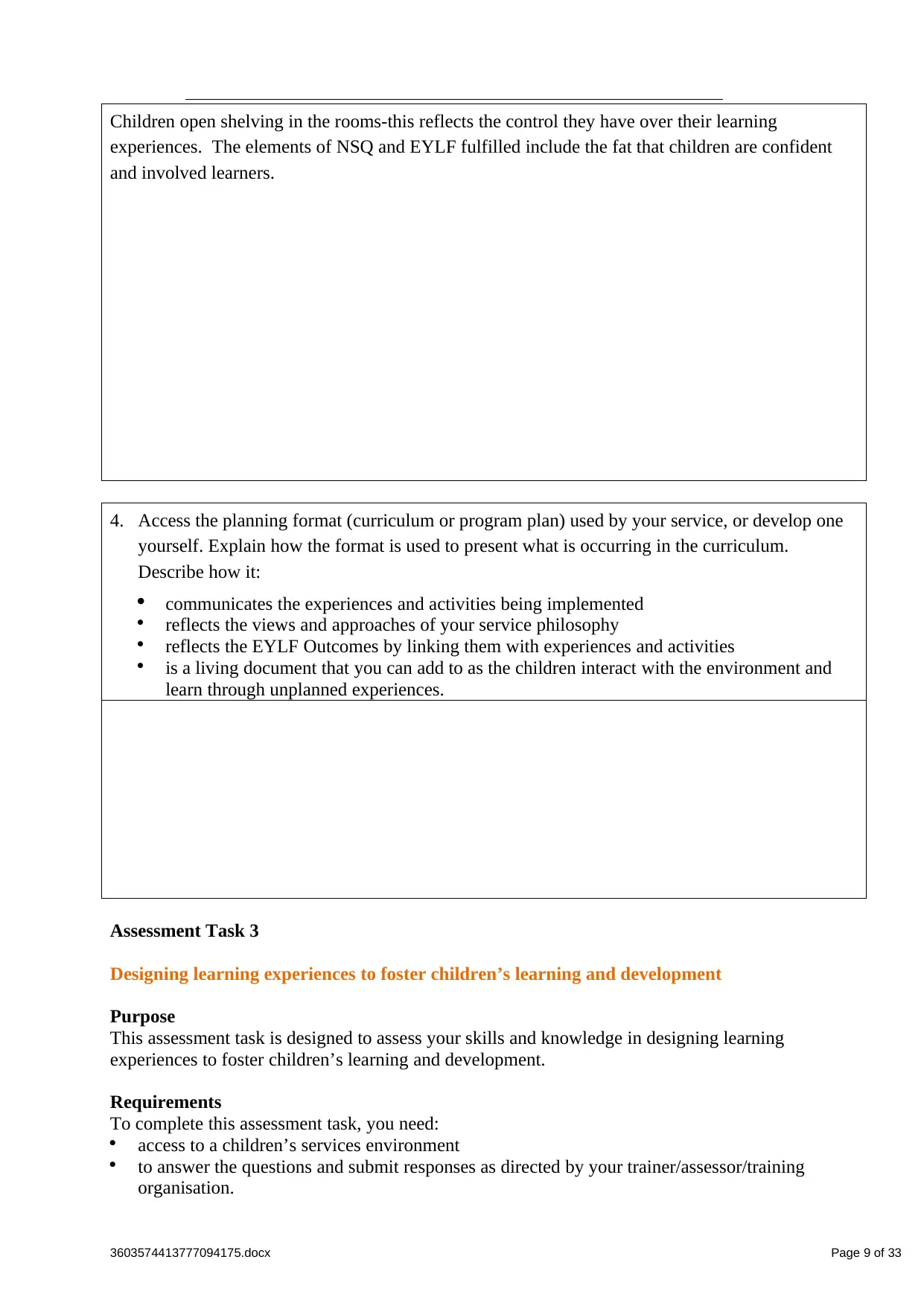
Children open shelving in the rooms-this reflects the control they have over their learning
experiences. The elements of NSQ and EYLF fulfilled include the fat that children are confident
and involved learners.
4. Access the planning format (curriculum or program plan) used by your service, or develop one
yourself. Explain how the format is used to present what is occurring in the curriculum.
Describe how it:
communicates the experiences and activities being implemented
reflects the views and approaches of your service philosophy
reflects the EYLF Outcomes by linking them with experiences and activities
is a living document that you can add to as the children interact with the environment and
learn through unplanned experiences.
Assessment Task 3
Designing learning experiences to foster children’s learning and development
Purpose
This assessment task is designed to assess your skills and knowledge in designing learning
experiences to foster children’s learning and development.
Requirements
To complete this assessment task, you need:
access to a children’s services environment
to answer the questions and submit responses as directed by your trainer/assessor/training
organisation.
3603574413777094175.docx Page 9 of 33
experiences. The elements of NSQ and EYLF fulfilled include the fat that children are confident
and involved learners.
4. Access the planning format (curriculum or program plan) used by your service, or develop one
yourself. Explain how the format is used to present what is occurring in the curriculum.
Describe how it:
communicates the experiences and activities being implemented
reflects the views and approaches of your service philosophy
reflects the EYLF Outcomes by linking them with experiences and activities
is a living document that you can add to as the children interact with the environment and
learn through unplanned experiences.
Assessment Task 3
Designing learning experiences to foster children’s learning and development
Purpose
This assessment task is designed to assess your skills and knowledge in designing learning
experiences to foster children’s learning and development.
Requirements
To complete this assessment task, you need:
access to a children’s services environment
to answer the questions and submit responses as directed by your trainer/assessor/training
organisation.
3603574413777094175.docx Page 9 of 33
⊘ This is a preview!⊘
Do you want full access?
Subscribe today to unlock all pages.

Trusted by 1+ million students worldwide
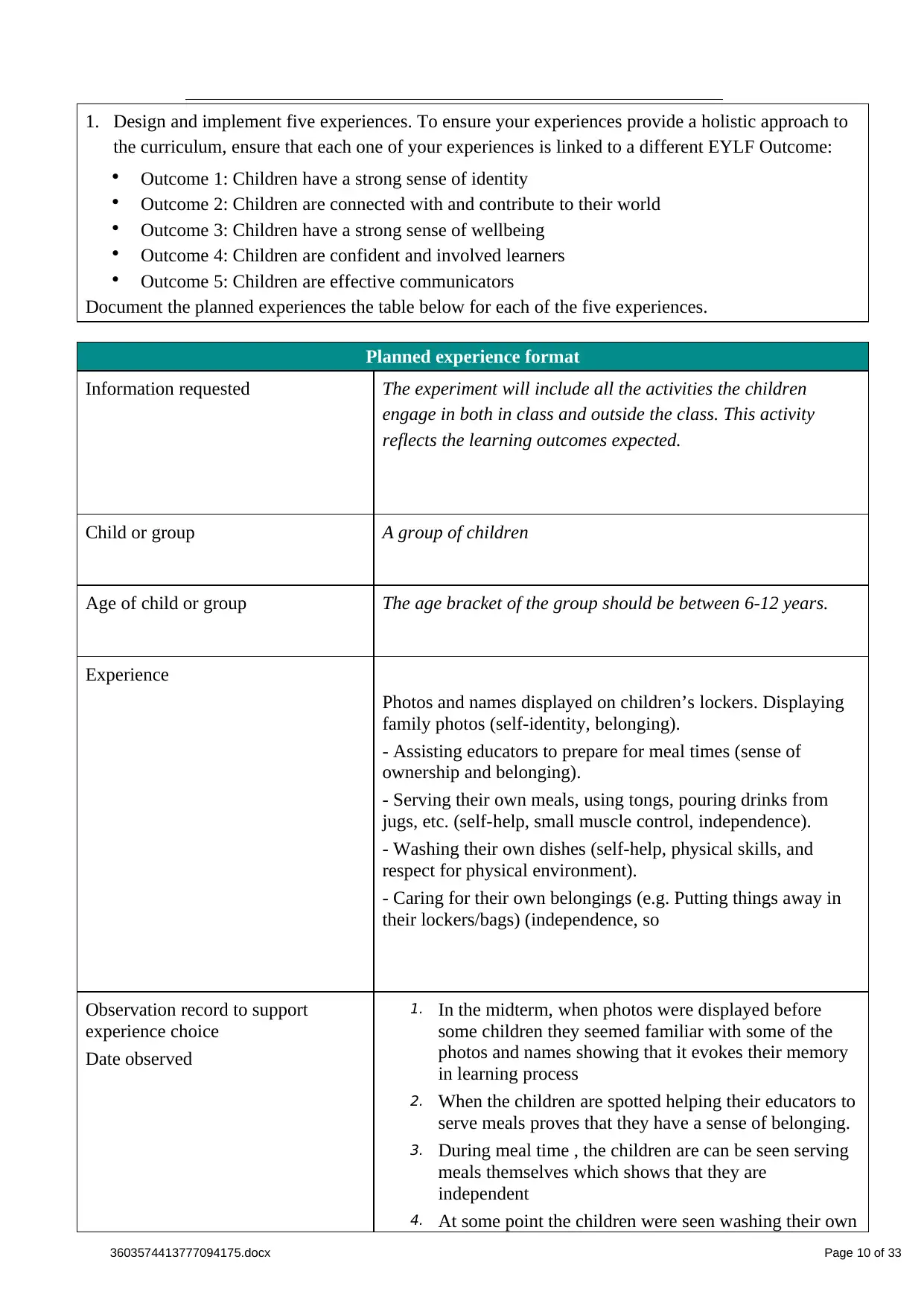
1. Design and implement five experiences. To ensure your experiences provide a holistic approach to
the curriculum, ensure that each one of your experiences is linked to a different EYLF Outcome:
Outcome 1: Children have a strong sense of identity
Outcome 2: Children are connected with and contribute to their world
Outcome 3: Children have a strong sense of wellbeing
Outcome 4: Children are confident and involved learners
Outcome 5: Children are effective communicators
Document the planned experiences the table below for each of the five experiences.
Planned experience format
Information requested The experiment will include all the activities the children
engage in both in class and outside the class. This activity
reflects the learning outcomes expected.
Child or group A group of children
Age of child or group The age bracket of the group should be between 6-12 years.
Experience
Photos and names displayed on children’s lockers. Displaying
family photos (self-identity, belonging).
- Assisting educators to prepare for meal times (sense of
ownership and belonging).
- Serving their own meals, using tongs, pouring drinks from
jugs, etc. (self-help, small muscle control, independence).
- Washing their own dishes (self-help, physical skills, and
respect for physical environment).
- Caring for their own belongings (e.g. Putting things away in
their lockers/bags) (independence, so
Observation record to support
experience choice
Date observed
1. In the midterm, when photos were displayed before
some children they seemed familiar with some of the
photos and names showing that it evokes their memory
in learning process
2. When the children are spotted helping their educators to
serve meals proves that they have a sense of belonging.
3. During meal time , the children are can be seen serving
meals themselves which shows that they are
independent
4. At some point the children were seen washing their own
3603574413777094175.docx Page 10 of 33
the curriculum, ensure that each one of your experiences is linked to a different EYLF Outcome:
Outcome 1: Children have a strong sense of identity
Outcome 2: Children are connected with and contribute to their world
Outcome 3: Children have a strong sense of wellbeing
Outcome 4: Children are confident and involved learners
Outcome 5: Children are effective communicators
Document the planned experiences the table below for each of the five experiences.
Planned experience format
Information requested The experiment will include all the activities the children
engage in both in class and outside the class. This activity
reflects the learning outcomes expected.
Child or group A group of children
Age of child or group The age bracket of the group should be between 6-12 years.
Experience
Photos and names displayed on children’s lockers. Displaying
family photos (self-identity, belonging).
- Assisting educators to prepare for meal times (sense of
ownership and belonging).
- Serving their own meals, using tongs, pouring drinks from
jugs, etc. (self-help, small muscle control, independence).
- Washing their own dishes (self-help, physical skills, and
respect for physical environment).
- Caring for their own belongings (e.g. Putting things away in
their lockers/bags) (independence, so
Observation record to support
experience choice
Date observed
1. In the midterm, when photos were displayed before
some children they seemed familiar with some of the
photos and names showing that it evokes their memory
in learning process
2. When the children are spotted helping their educators to
serve meals proves that they have a sense of belonging.
3. During meal time , the children are can be seen serving
meals themselves which shows that they are
independent
4. At some point the children were seen washing their own
3603574413777094175.docx Page 10 of 33
Paraphrase This Document
Need a fresh take? Get an instant paraphrase of this document with our AI Paraphraser
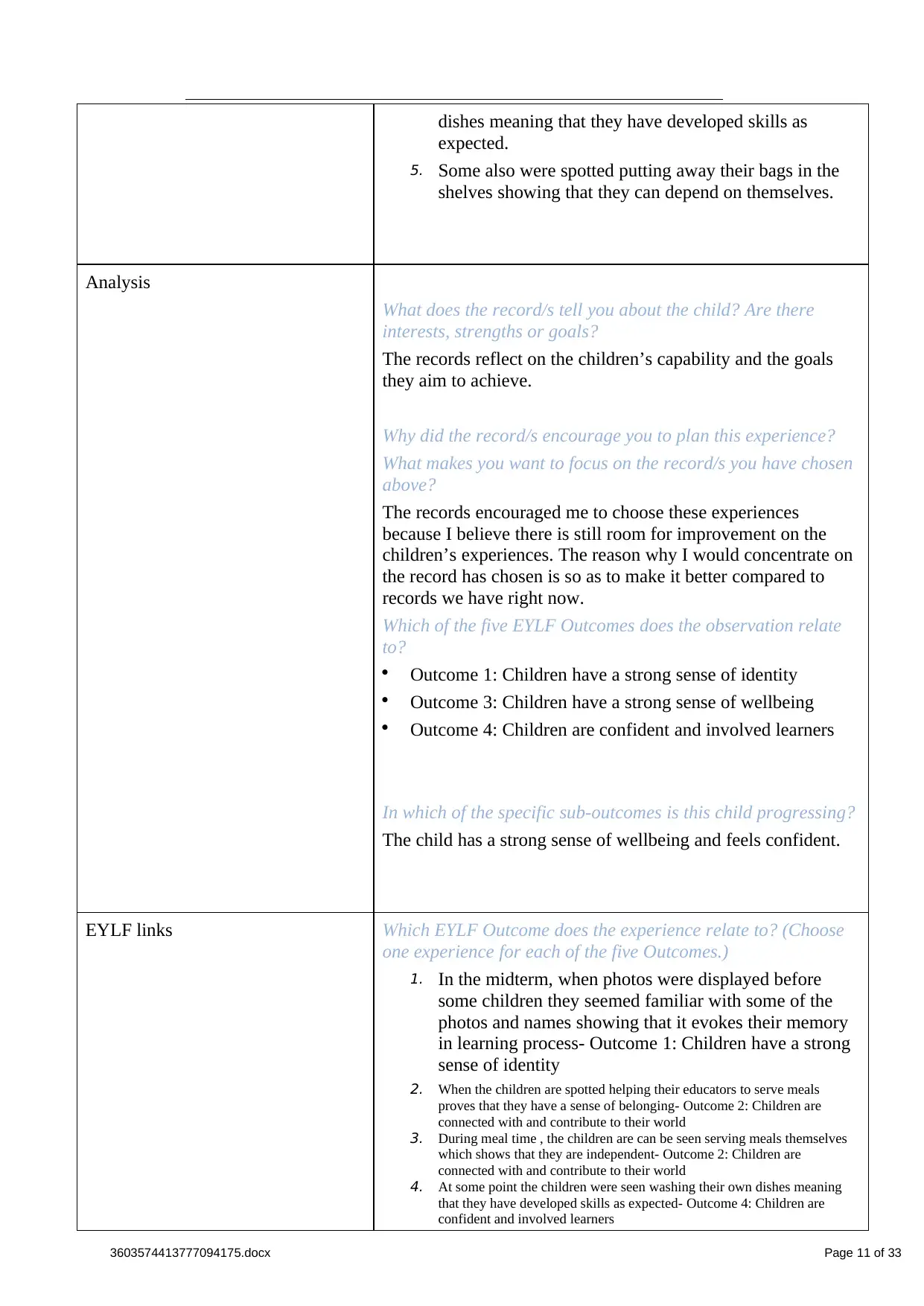
dishes meaning that they have developed skills as
expected.
5. Some also were spotted putting away their bags in the
shelves showing that they can depend on themselves.
Analysis
What does the record/s tell you about the child? Are there
interests, strengths or goals?
The records reflect on the children’s capability and the goals
they aim to achieve.
Why did the record/s encourage you to plan this experience?
What makes you want to focus on the record/s you have chosen
above?
The records encouraged me to choose these experiences
because I believe there is still room for improvement on the
children’s experiences. The reason why I would concentrate on
the record has chosen is so as to make it better compared to
records we have right now.
Which of the five EYLF Outcomes does the observation relate
to?
Outcome 1: Children have a strong sense of identity
Outcome 3: Children have a strong sense of wellbeing
Outcome 4: Children are confident and involved learners
In which of the specific sub-outcomes is this child progressing?
The child has a strong sense of wellbeing and feels confident.
EYLF links Which EYLF Outcome does the experience relate to? (Choose
one experience for each of the five Outcomes.)
1. In the midterm, when photos were displayed before
some children they seemed familiar with some of the
photos and names showing that it evokes their memory
in learning process- Outcome 1: Children have a strong
sense of identity
2. When the children are spotted helping their educators to serve meals
proves that they have a sense of belonging- Outcome 2: Children are
connected with and contribute to their world
3. During meal time , the children are can be seen serving meals themselves
which shows that they are independent- Outcome 2: Children are
connected with and contribute to their world
4. At some point the children were seen washing their own dishes meaning
that they have developed skills as expected- Outcome 4: Children are
confident and involved learners
3603574413777094175.docx Page 11 of 33
expected.
5. Some also were spotted putting away their bags in the
shelves showing that they can depend on themselves.
Analysis
What does the record/s tell you about the child? Are there
interests, strengths or goals?
The records reflect on the children’s capability and the goals
they aim to achieve.
Why did the record/s encourage you to plan this experience?
What makes you want to focus on the record/s you have chosen
above?
The records encouraged me to choose these experiences
because I believe there is still room for improvement on the
children’s experiences. The reason why I would concentrate on
the record has chosen is so as to make it better compared to
records we have right now.
Which of the five EYLF Outcomes does the observation relate
to?
Outcome 1: Children have a strong sense of identity
Outcome 3: Children have a strong sense of wellbeing
Outcome 4: Children are confident and involved learners
In which of the specific sub-outcomes is this child progressing?
The child has a strong sense of wellbeing and feels confident.
EYLF links Which EYLF Outcome does the experience relate to? (Choose
one experience for each of the five Outcomes.)
1. In the midterm, when photos were displayed before
some children they seemed familiar with some of the
photos and names showing that it evokes their memory
in learning process- Outcome 1: Children have a strong
sense of identity
2. When the children are spotted helping their educators to serve meals
proves that they have a sense of belonging- Outcome 2: Children are
connected with and contribute to their world
3. During meal time , the children are can be seen serving meals themselves
which shows that they are independent- Outcome 2: Children are
connected with and contribute to their world
4. At some point the children were seen washing their own dishes meaning
that they have developed skills as expected- Outcome 4: Children are
confident and involved learners
3603574413777094175.docx Page 11 of 33
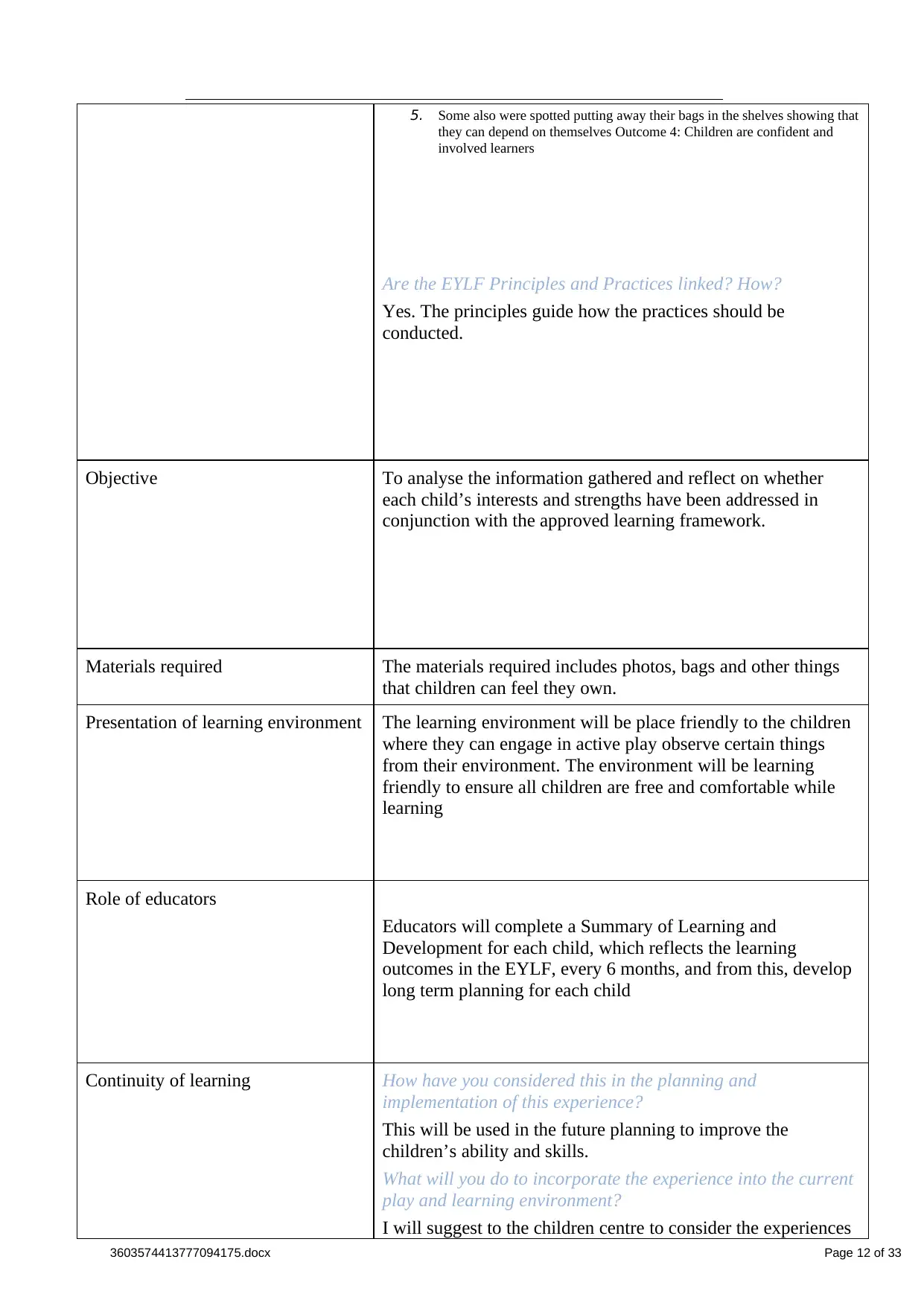
5. Some also were spotted putting away their bags in the shelves showing that
they can depend on themselves Outcome 4: Children are confident and
involved learners
Are the EYLF Principles and Practices linked? How?
Yes. The principles guide how the practices should be
conducted.
Objective To analyse the information gathered and reflect on whether
each child’s interests and strengths have been addressed in
conjunction with the approved learning framework.
Materials required The materials required includes photos, bags and other things
that children can feel they own.
Presentation of learning environment The learning environment will be place friendly to the children
where they can engage in active play observe certain things
from their environment. The environment will be learning
friendly to ensure all children are free and comfortable while
learning
Role of educators
Educators will complete a Summary of Learning and
Development for each child, which reflects the learning
outcomes in the EYLF, every 6 months, and from this, develop
long term planning for each child
Continuity of learning How have you considered this in the planning and
implementation of this experience?
This will be used in the future planning to improve the
children’s ability and skills.
What will you do to incorporate the experience into the current
play and learning environment?
I will suggest to the children centre to consider the experiences
3603574413777094175.docx Page 12 of 33
they can depend on themselves Outcome 4: Children are confident and
involved learners
Are the EYLF Principles and Practices linked? How?
Yes. The principles guide how the practices should be
conducted.
Objective To analyse the information gathered and reflect on whether
each child’s interests and strengths have been addressed in
conjunction with the approved learning framework.
Materials required The materials required includes photos, bags and other things
that children can feel they own.
Presentation of learning environment The learning environment will be place friendly to the children
where they can engage in active play observe certain things
from their environment. The environment will be learning
friendly to ensure all children are free and comfortable while
learning
Role of educators
Educators will complete a Summary of Learning and
Development for each child, which reflects the learning
outcomes in the EYLF, every 6 months, and from this, develop
long term planning for each child
Continuity of learning How have you considered this in the planning and
implementation of this experience?
This will be used in the future planning to improve the
children’s ability and skills.
What will you do to incorporate the experience into the current
play and learning environment?
I will suggest to the children centre to consider the experiences
3603574413777094175.docx Page 12 of 33
⊘ This is a preview!⊘
Do you want full access?
Subscribe today to unlock all pages.

Trusted by 1+ million students worldwide
1 out of 33
Related Documents
Your All-in-One AI-Powered Toolkit for Academic Success.
+13062052269
info@desklib.com
Available 24*7 on WhatsApp / Email
![[object Object]](/_next/static/media/star-bottom.7253800d.svg)
Unlock your academic potential
Copyright © 2020–2025 A2Z Services. All Rights Reserved. Developed and managed by ZUCOL.




